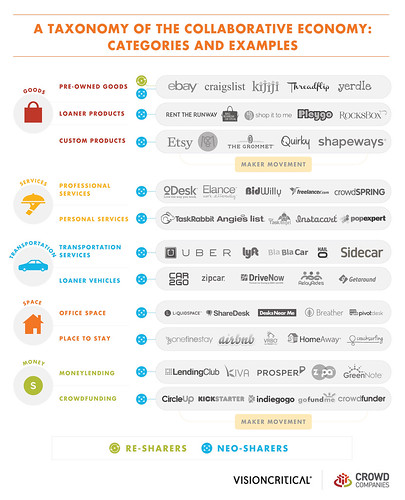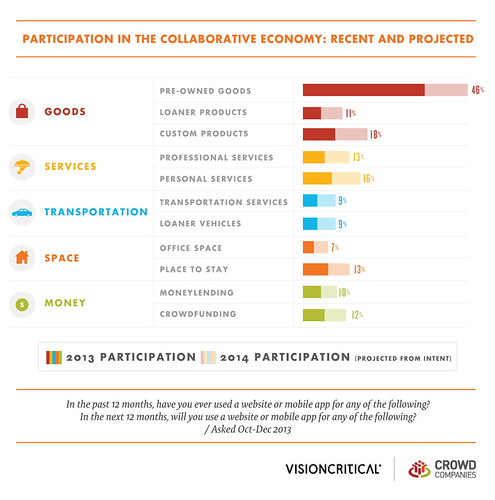The Collaborative Economy Movement Changes Business
This report offers critical insight for big brands who are grappling with the emergence of the Collaborative Economy, and for the startups that are driving this growth. For those new to the term, the collaborative economy is a powerful, if nascent, movement in which people are getting the things from each other, it’s a combination of trends like the sharing economy, maker movement, and co-innovation.
[In the growing Collaborative Economy, people fund, make, and share things with each other –rather than buy from inefficient corporations]
That means that people go to a site like LendingClub to get funding for their new project, rather than a traditional bank. Or, they may go to a site like Etsy or Shapeways to get custom made goods, or go to a site like eBay to buy pre-owned goods, instead of buying new products from retailers. In each of these cases, the crowd is self-empowered to get what they need from each other.
But while the collaborative economy is poised to disrupt many industries, there is remarkably little data on how many people participate in sharing and making, who they are, and, most importantly, why they do it. Our report paints a picture of the sharers in the collaborative economy and provides important recommendations for businesses that want to win in this new economy.
The Largest Study of the Collaborative Economy
By engaging 90,112 people the US, Canada and the UK, we uncovered three distinct types of people who participate in the collaborative economy:
- Re-sharers: Those who buy and/or sell pre-owned goods online (for example, on Craigslist or eBay), but have not yet ventured into other kinds of sharing.
- Neo-sharers: People who use the newer generation of sharing sites and apps, like Etsy, TaskRabbit, Uber, Airbnb and KickStarter.
- Non-sharers: People who have yet to engage in the collaborative economy. Although many of these non-sharers intend to try sharing services (in particular, re-sharing sites like eBay) in the next 12 months.
Crowd Companies and Vision Critical Team Up
In Dec, I launched Crowd Companies, an association for large brands that want to partner with the Collaborative Economy, to help these large companies navigate, find partners and shift their business models, hard data is needed to make real decisions. Partnered with Vision Critical, we’ve worked hard to launch a survey across 90,000+ respondents in USA, Canada, and the UK, to find out exactly how they share, buy custom goods, P2P lend, and crowd fund. Crowd Companies council members will receive a private briefing with myself and Alexandra Samuel, my co-author, and we’re hosting an event for council members at SXSW this coming Friday.
This report contains the following:
- Introduction and summary
- Breakdown of the three groups of sharing customers
- Market adoption rates
- Taxonomy of the market
- Breakdown by demographic: age, location, political party, marriage status and more.
- Satisfaction rates of sharing services
- Forecast of future behaviors and growth rates by sector
- Recommendations for corporations: market opportunities, and specific departmental impacts.
Key graphics
There are nine graphics, which we’ll explore in future blog posts, here’s two key frameworks and graphics at industry level.

Above: We’ve segmented part of the collaborative economy (there are still unexplored areas such as co-innovation, 3d printing and crypto-currencies) into five major categories: goods, services, space, transportation, and money sharing. These span the sharing economy and maker movement. In both methods, this enables people to get what they need from each other –rather than buy it from inefficient corporations.

Above: We asked the thousands of respondents about their intended usage over the next 12 months, helping us to forecast behavior usage based on explicit responses. There’s significant growth in the sharing of used goods (up to 46%), but the overall growth rate will slow. Neo-sharing services are on the rise as custom services, personal services, places to stay, crowdfunding and moneylending to achieve double digit adoption rates.
Above: The larger infographic, which you can embed on your site.
Report Resources
Read, use, and share the following:
- Flickr: Set of nine infographics
- Slideshare: Full PDF report (also embedded above)
- Slideshare: Full infographic (also embedded above)
- Slideshare: All graphics on one document
- My body of work on the collaborative economy movement
Related Reviews
Ill cross-link to key reviews of this report, leave a comment below if I miss one, or reply via a tweet.
- Vision Critical Blog: Why sharing is the new buying
- Fast Company: The Collaborative Economy Is Exploding, And Brands That Ignore It Are Out Of Luck
- Amy Bishop on how businesses can develop strategies in this market
- Mindjet: Sharing is the new buying
- Neville Hobson: New research shows what drives the collaborative economy
- Business Wire: With the core facts from the release
- Hubspot: The Collaborative Economy Is Coming for Your Business. Are You Ready?
- Ken Mueller: The Emerging Collaborative Economy: An Opportunity for Small Business
- B2C: The Emerging Collaborative Economy: An Opportunity For Small Businesses
- Scott Monty: Collaboration, sharing is the new buying
- Shift Communications Christopher Penn discusses why physical sharing increases earned media
- Shareable: New research sharing to double in next year
- eBay Blog: Customers in the Collaborative Economy
- Sustainable Brands: New Report Maps Size, Scope, Disruptive Potential of Sharing Economy
- Jonathan Wichmann a social business and logistics experts covers the report
- The Hook: Nearly half of Canadians taking part in ‘collaborative economy’: report
- Shel Holtz: The first substantive report on the burgeoning collaborative economy
- Harvard Business Review: Established Companies, Get Ready for the Collaborative Economy
- eBusiness Planet: See what drives the collaborative economy
- Viralblog: Sharing is the new buying
- Peers: How sharing is happening, via word of mouth
- Crowdsourcing.org covers the report
- For Immediate Release podcast mentions the report
- Ann Hawkins: The Collaborative Economy is going corporate
- Marketing Charts summarizes the report and data
- Linkedin Pulse, Beth Kanter discusses our SXSW panel which covered the report
- Audio: Social Media Show: How social is normalizing sharing
- IBM’s Sandy Carter references the report in her SXSW review video
- TechVibes: Sharing is the New Buying: How Brands Can Win in the Collaborative Economy
- David Deal writes: The Collaborative Economy goes mainstream
- VentureBeat: Wake up your company to the collaborative economy
- Salon: “Sharing economy” shams: Deception at the core of the Internet’s hottest businesses
- B2C: How to Develop Winning Business Strategies in the Collaborative Economy [Research]
- The Sharing Economy of Healthcare
- Jeremiah Owyang: Sharing is the New Buying how to win in the collaborative economy
- Probono Australia: Profiling the Collaborative Economy
- New Geography: The part time, freelance, collaborative economy
- AdRants: What you need to know about the Collaborative Economy
- Marketing Mag features the infographic
- CMSWire: The Promises, the Challenges of Real Time
Methodology:
This report is based on two surveys conducted between October 2013 and January 2014 by Vision Critical’s Voice of Market with participants from the U.S., U.K. and Canada ages 18 and over. The initial survey of 90,112 respondents provided data on the overall incidence, frequency and nature of participation in the collaborative economy. The questions regarding the collaborative economy were imbedded in a general omnibus survey covering a variety of topics. The topic of the collaborative economy was not mentioned in the invitation to the survey. A follow-up survey of over 2,500 sharers provided deeper insight into the nature of participation in the collaborative economy and in particular, on respondents’ most recent sharing transactions. The data is demographically representative of the adult (18+) populations of the U.S., U.K. and Canada. The results were weighted by age, gender, region and education, to be representative of the demographics of each nation. The margin of error–which measures sampling variability–is +/- 0.3% for the sample of 90,112 and +/- 2% for the sample of 2,517, 19 times out of 20.
Special thanks to the extended Vision Critical team, including , Andrew Reid, Alexandra Samuel, Andrew Grenville, Jenny Smelyanets, and others.
Thanks it would be interesting to expand this kind of study to other european countries. Laurent Bouty (www.bouty.net)
New words are being developed such as coopetition that reflect this new way of thinking. Trust is becoming a valued commodity in business.
Matt, that’s right, and also the Coop business model is one being discussed for companies to adopt. It’s a long way off for any Fortune 500 to look at such a model, but I hear it out of the startup community.
Laurent, that’s a great idea, I agree, further studies can and should be done. I know of one that was done in specific cities –but not broad sets of countries. I’m fortunate to partner with Vision Critical who has the scope and depth to make this happen.
Thanks Jeremiah, getting an european perspective will allow us to compare with US or UK data. As Vision Critical are present in FR, DE and UK, they surely might be able to do that.
By engaging 90,112 people the US, Canada and the UK, we uncovered three distinct types of people who participate in the collaborative economy:
Want his head on a pike, eh Al? LOL.
There is certainly a great deal to find out about this issue.
I love all of the points you made.